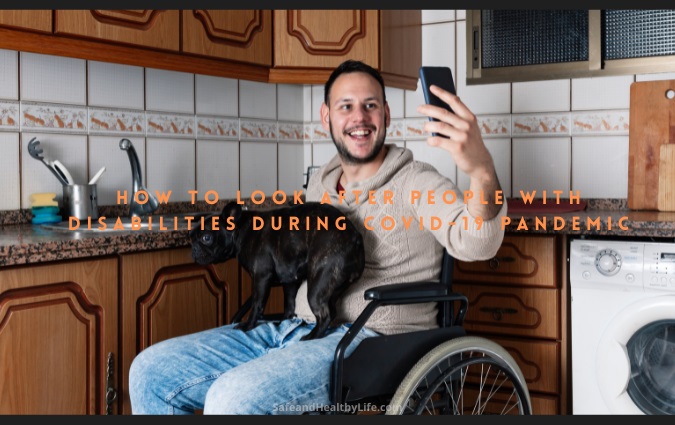[ad_1]

The COVID-19 pandemic has been tough on many people, including disabled individuals. With implications for work, digital inclusion, and access to care and support at home, most disabled people have suffered during the pandemic.
Most of them had to deal with anxiety, loneliness, or depression. Chances are that some of them might be living with their family. But how do families take care of disabled individuals without professional care or support?
It is important to understand risk factors and other issues associated with COVID-19 to take care of a disabled individual in a better way.
Understanding the COVID-19 through concepts of disability
Disability is a diverse condition. Some health conditions related to a disability may lead to extensive healthcare requirements or poor health.
However, some may not need any of this. But people with disabilities have some general healthcare requirements like others. Therefore, they need better access to major healthcare services.
According to Article 25 of the UN Convention on the Rights of Persons with Disabilities (CRPD), the right of disabled people attains higher healthcare standards with no discrimination.
Understanding disability-related COVID-19 risk factors
People with disabilities are considered to be at higher risk of death or serious illness from COVID-19. it is because of higher rates of already existing health issues such as asthma, diabetes, chronic pulmonary obstructive disease, etc.
People with disabilities are most likely to be socially isolated, or not working. It makes them highly vulnerable to bad health outcomes during the coronavirus pandemic.
Health inequities may worsen at the time of epidemics. It is because the marginalized communities have lesser resources and also struggle to access required services and supplies.
People with disabilities should not be de-prioritized when there is an increasing demand for health services. However, according to recent reports, elderly with disabilities are often de-prioritized in health sectors.
Health services may be insufficient for people with disabilities due to certain barriers such as lack of understanding of an individual’s disability, physical inaccessibility, and price factor.
People with a disability may be at more risk of being infected by the coronavirus:
- They are most likely to get infected with severe illness due to COVID-19. They are likely to have major illnesses or infections due to some underlying health conditions, systemic health, congregate lifestyle, and social inequities.
- Most people with serious underlying health conditions such as heart conditions, chronic lung disease, or weakened immune systems seem to get more ill due to COVID-19. Disabled adults are three times more like to have diabetes, heart condition, cancer, or stroke than those without disabilities.
The risk of getting infected or having an unknown illness amongst disabilities may be higher because:
- They are not able to communicate illness symptoms
- They have a problem understanding any information or practice preventing measures such as social distancing and hand washing.
- Inability to avoid contact with those who might be COVID-19 infected, which may include family members and/or direct support providers.
Things to know about living with a disability during the COVID-19 pandemic
Here are some important things to know about living with a disability during COVID-19:
- Social distancing, washing hands, and following health guidelines are some important things to fight against the virus.
- People with disabilities are vulnerable to co-morbidities and secondary conditions such as diabetes, lung problems, obesity, and heart disease. So, it is important to be careful while coming in contact with others.
- Living in institutions also increases the risk of dying or contracting COVID-19. Care homes where the elderly with disabilities live also have higher infection rates. COVID-19 related death rate ranges from 19% to 72% in such institutes.
- Despite a revolutionary surge in interior areas, entertainment, education during the pandemic, people with disabilities have lost their jobs, support services, and access to education. They are also at higher risk of domestic violence during the pandemic.
Five ways to meet the needs of people with disabilities during COVID-19
Here are some easy ways to meet the requirements of people with disabilities during COVID-19:
Consider unique needs: Ensure their unique needs, including food requirements, national security requirements, caregiving facilities, and more. This way people with disabilities are likely to live a better life.
Coordinate: Civil society organizations and governments need to work hand-in-hand with associations of people living with disabilities. For instance, they need to work together to provide support, coordinate care, and ensure the rights of disabled people are protected.
Concentrate on primary care: It is essential to strengthening primary health care services for people with disabilities. To achieve this, community health workers need to do home visits and they need to be trained for non-specialized services to stabilize a patient.
Patient-centric approach: Disability support and care providers need to take a patient-centered approach along with individualized care. They must have an option to pick alternate options and even opt-out for being categorized as someone whose life is less worthy than anyone else.
Curriculum for disabled people: Finally, develop a proper curriculum for disabled people through professional training in all tiers of health care. It is best to work with medical students, social workers, nurses, pharmacists, and others to take care of people with disabilities during the COVID-19 pandemic.
About The Author:
Monika is a professional content creator with over six years of experience in various niches. She has dedicated her life to share her knowledge and experience with the world through words. She loves interacting with readers and often encourages them to ask questions related to her writeups.
[ad_2]
Source link




